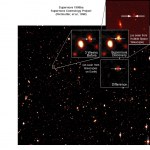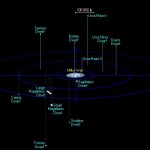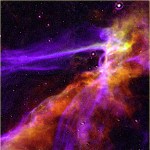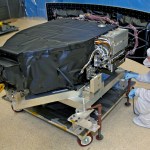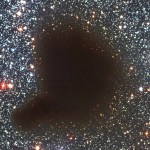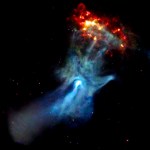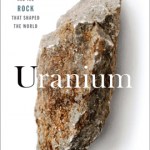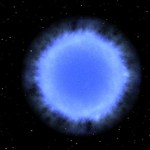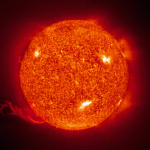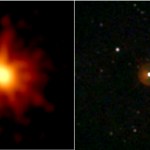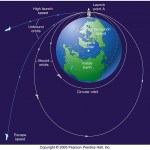Supernovae
Though the Sun is gone, I have a light. -Kurt Cobain
Last time we visited dark energy, we discussed its initial discovery. This came about from the fact that supernovae observed with a certain redshift (i.e., moving away from us) appear to be systematically fainter than we were able to explain.
But we weren't satisfied with simply saying that there must be dark energy. We asked a lot of critical questions about why these supernovae might appear so faint.
First off, we asked the question, "Could these supernovae from far away be different than the type Ia supernovae we have today?"…
Last time, we talked about the discovery of dark energy. How did it happen? Well, there are certain kinds of Supernovae, type Ia supernovae, that are practically identical to one another all across the Universe. In fact, we had one happen in our own galaxy in 1572; it outshone everything besides the Moon in the night sky for weeks.
How do type Ia supernovae work? Many solar systems out there are like our own, with one star dominating the system. Others, however, have two or more stars present in the system. Stars up to about four times the mass of our Sun, when they finish burning their…
By the 1990s, we knew an awful lot about the Universe. You can check out what the greatest discoveries were (in my opinion) from the 1910s, 1920s, 1930s, 1940s, 1950s, 1960s, 1970s, and 1980s. By this point, we understood the origin of the Universe as well as we understand it today, knew about dark matter and normal matter, and were trying to figure out what the fate of the Universe was. It started with a bang (of course), with a supremely hot (~10^20 degrees), dense, and rapidly expanding state (image courtesy of Stephen van Vuuren):
We knew that there were (and are) two things going on,…
By the 1980s, our view of the Universe was pretty close to what it is today. We had confirmed the Big Bang Theory and even had some understanding of what must've caused the Big Bang. There were some mysteries around, such as dark matter, the age of the Universe, and the solar neutrino problem, but all in all, we were on pretty solid ground.
One of the things astronomers had been waiting for was a supernova to go off in our galaxy. We expect about one per century in our galaxy, and we hadn't seen one since 1604! It's 2009 now, and we still haven't seen one, but in 1987, we got closer than any…
Earlier this week, I wrote about how the heavier elements in the Universe were made. Specifically, that they are made in stars. These stars then explode in a variety of ways, enriching the Universe with these heavy elements, and allowing us to form glorious things, like our planet!
By contrast, the big bang makes light elements, but not heavy ones. Why is this the case, and how do we know? Let's find out.
Image credit: Stephen Van Vuuren, created from a simulation of 80,000 star images.
Just a few seconds after the big bang, the Universe is filled with protons and neutrons, in roughly the…
There are many great discoveries that happened in the 1930s that changed our view of the Universe. From tiny discoveries (the neutron) to huge ones (Pluto), from theoretical explanations of antimatter to the neutrino to the start of quantum field theory, the 1930s were a great time for making new discoveries. But one man often gets left out of these discussions, IMO, because he was too far ahead of his time.
Meet Fritz Zwicky. Born in Bulgaria, a citizen of Switzerland, and did his best work at Caltech. (In fact, his daughter Barberina has noticed my old site!) Fritz was in the very tough…
It is done! The longest-running and most famous camera in the world, Hubble's WFPC2, has been removed and replaced. Scientists will now get to use the Wide-Field Camera 3 (below), and WFPC2 is headed to the Smithsonian.
You've already gotten a chance to taste what WFPC2 has done for our understanding of the Universe, Planets, Galaxies, and Clusters of Galaxies in the first four parts of our series on The Camera that Changed the Universe. What else is left?
Part FiveWell, the only thing I didn't cover yet is stars. And yet, perhaps no other tool -- ever -- has been more useful for discovering…
Stars are like everything else in the Universe (to quote E.B. White): we're born, we live a little while, we die. The thing that people may not realize is this: stars have been doing this since before the Universe was visible! What do I mean by this? Take a look at this nebula, Barnard 68.
What's going on here? This is what astronomers call "dust", and what everyone else on Earth calls "neutral hydrogen atoms." Yes, puny mammal, practically all of the atoms in space are ionized hydrogen, and this is a good thing. How does this happen? You form stars, and the high-energy light (Ultra-Violet…
Someone at the New York Daily News must have started celebrating April 20th a bit early. Because this beautiful supernova remnant, with a spinning, pulsing neutron star at the center:
is no excuse to run a poll asking readers if this is either the Hand of God or a natural stellar formation.
I could tell you about the power of PZ, and how since writing his post last week the numbers have gone from 40/60 to 5/95, but I'd rather tell you the one thing that every lefty knows: God is right-handed.
Thanks a lot -- on behalf of all lefties -- for the reminder, big guy.
Last night, I was watching the Daily Show, and they had Tom Zoellner on, talking about his new book: Uranium: War, Energy, and the Rock that shaped the world.
There are certainly a lot of interesting things about Uranium in culture, particularly in terms of energy (hey, we can use this thing to power the world) and in terms of war (the nuclear arms race). If you look at what we've done with all the enriched Uranium (U-235, the fissionable type), the US and the Soviets, from the 1940s to the 1980s, basically took nearly all of it and stockpiled it.
This is the only element on Earth we've ever…
We know, more or less how supernovae work. We've seen them just hours after they first go off through telescopes and satellites. The Crab Nebula, also known as M1, was a supernova that went off nearly 1,000 years ago in our own galaxy, for example, and we can simulate pretty well that it formed like this:
But this is totally new: a paper is coming out in the journal Nature tomorrow (the 22nd of May), where they've caught a star exploding red-handed!
First things first; here's a quicktime movie of the explosion. Let's put up some screenshots of the Blue Giant star before the explosion:
Here'…
You've all heard these words before. Dark Energy. But what is it, and why are we stuck with it? Let me start by telling you a story.
Imagine, for a minute, that you have a candle. You know everything about this candle, including how bright it is and how far away it is from you. Like so:
Now if I move this candle twice as far away, I know it's going to be one-fourth as luminous. If I move it three times as far away, I know it's going to appear one-ninth as luminous. And if I move it a thousand times farther away, I know what I see is going to be one-millionth as luminous as the original…
What's going to happen to all the stars in the Universe as they get older? Well, just as nothing can live forever, stars can't live forever also. Why? Because they run on fuel: burning hydrogen into helium, for example. When they run out of fuel, something's gotta give. Barbara Ryden reminds us of an excellent and appropriate quote by Dylan Thomas:
Do not go gentle into that good night.
Rage, rage against the dying of the light.
But what exactly happens to the star depends very sensitively on what the mass of the star is.
If you've got a tiny little star, less than about 40% of the mass of…
Those of you who keep up with your news may have seen this headline on CNN last week: Star Explodes Halfway Across Universe. What they're talking about is a Gamma-Ray Burst, which was so bright that, despite being 7.5 billion light years (that's 2.3 Gpc) away, it was still visible on Earth with the naked eye. From the article:
The aging star, in a previously unknown galaxy, exploded in a gamma ray burst 7.5 billion light years away, its light finally reaching Earth early Wednesday.
This is the sort of thing that the SWIFT satellite was designed to detect, pinpoint, and then tell Earth-based…
You and I have lived on planet Earth long enough to know that if you want to launch something into space, it needs to travel fast enough to escape the pull of Earth's gravity. Launch it with too slow of a speed, and it crashes back into Earth. Launch it with a little more speed, and you can send it into orbit (like a satellite). But launch it fast enough, and it can escape from Earth's gravity altogether. The speed to completely escape from Earth's gravity is pretty fast: about 11.2 km/s, or 7 miles per second!
Make something denser and more massive, and you'll have to go faster and faster…
